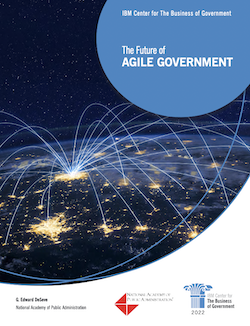This post first appeared on IBM Business of Government. Read the original article.

In software development, agile techniques feature small, cross-functional, selforganizing teams that include customers working quickly to deliver solutions in increments that immediately provide value.
The development is customer-centric
and collaborative networks are used for development and deployment. Agile
developers use “scrums” and “sprints” as techniques to produce products quickly
that have a high degree of customer acceptance and satisfaction. Agile principles
continue to guide projects and programs involving software development today.
In this report, Ed DeSeve builds on his prior work as leader for the AGC to
expand how agile principles can apply to the development and implementation
of government policies, regulations, and programs. The author introduces the
“Integrated Agile Framework for Action”, to guide government leaders and stakeholders
in implementing agile strategies in their work to provide services to the
public in a way that fosters public trust. DeSeve concludes with multiple recommendations
for government leaders and agile innovators, including:
- Agile leaders at all levels need an agile mindset. This means a willingness
to try new ideas and processes to achieve better results. - Government needs intentional leadership development strategies.
Equipping leaders at all levels via a common approach to agile principles
drives successful transformation. - Integration is critical to execution. The elements described in the framework
are designed to work together. - Leaders at all levels need to analyze and understand trust in and across
their organization. Trust is key for populations including employees, the public,
and partners. - Agile government must begin with understanding customers. Analyzing the
customer experience and journey starts with understanding who the customers
are, how their journey with the organization flows, what constitutes
“defining moments” in their experience, and continuous monitoring of customer
views. - Public values must be respected and the public must be engaged. These
values include a focus on openness, integrity, and fairness, which can
improve overall trust - Networks should form the default development and implementation pathway wherever possible.
Collaborative networks can be internal, external, international, or some combination of these, and should
serve as a force multiplier for mission execution. - Cross-functional teams should drive integrated solutions to problems. Cross-functional teams bring
more perspectives and encourage diversity of thought in creating and executing new solutions, greatly
enhancing the chances for success. - Appropriate speed and persistent iteration will enable the organization to shape and reshape successful
approaches. Setting aggressive deadlines to accomplish work and demonstrate continual achievement
builds internal and external support. - Simultaneous execution of agile government actions is required. Agile government is not a sequential
process, but rather an integrated series of actions designed to increase organizational competence while
respecting public values.
The report builds on the considerable body of work released through the AGC since its creation three years
ago. The AGC serves as the hub of a network that brings together governments, nonprofits, foundations, academic
institutions, and private sector partners to assist in developing and disseminating agile government
principles and case studies of agile policies and programs. This global network provides support for those
who want to adopt and implement agile principles to provide public goods and services that fully meet customer
needs and build public trust, and to identify cases of effective agile government in practice. DeSeve
outlines many such cases in this new report.
Prior relevant reports published by the IBM Center and the Academy’s AGC include Human Centricity in
Digital Delivery: Enhancing Agile Governance, by Ines Mergel; Agile Learning: the Role of Public Affairs Education,
by Angela Evans; Adopting Agile in State and Local Governments, by Sukumar Gapanati; and Ed DeSeve’s initial
report, The Road to Agile Government: Driving Change to Achieve Success. In addition, the AGC has published
Building an Agile Federal Government, released by the Academy with support from the Samuel Freeman
Charitable Trust and the Project Management Institute.
We hope this report provides a path to further progress for government leaders and stakeholders on how agility
can drive improved operations, service delivery, and public trust, in the U.S. and around the world.
